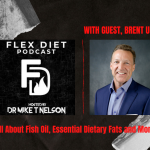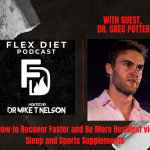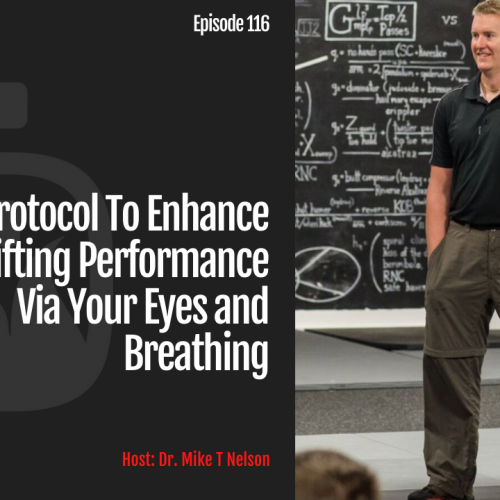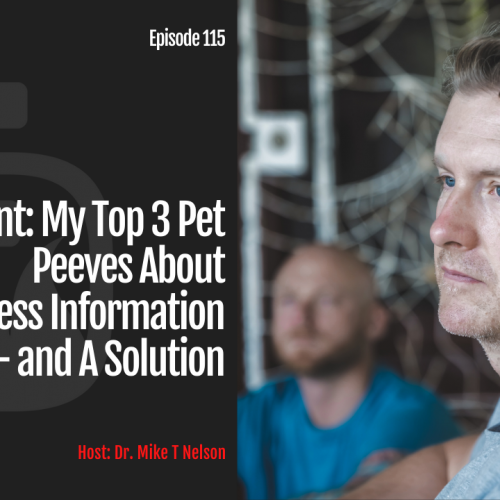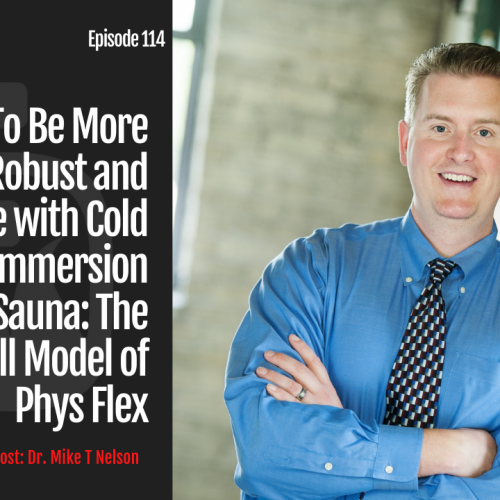Today we’re talking about goal setting in a different way from what you’re used to hearing. You’ll take away practical tips you can use that are highly effective for yourself or with your clients.
Episode Notes
- Intentions with a rough timeframe are better than goals with a strict timeframe.
- Figure out the gap – what’s missing. SAID principle.
- Figure out the cost. HRV, joint pain, time spent exercising…
- Basic boring is best (3 Bs)
Today’s podcast is brought to you by Dr. Mike himself. Check out the new and improved website and make sure to sign up for my daily newsletter to receive all my free content.
Or watch on YouTube:
Rock On!
Dr Mike
P.S. Catch up on any missed Flex Diet Podcasts!
Transcript:
Dr. Mike T Nelson (00:01):
Hey, what’s going on. It’s Dr. Mike T. Nelson here back with another podcast on the flux diet podcast. And today it’s just me talking about a huge tip for goal setting and how to view it and the new year 2021. So hopefully you had a wonderful holidays and you’re headed into 2021 in the right direction. And today’s podcast is sponsored by me. You can go to my website, which is Mike T nelson.com. And very soon, depending on when you’re listening to this, hopefully when you’re listening to this later, I will have a brand new website up for you. So pretty excited about that. We’re putting a lot more content there. And a lot of the content that I write goes out to my newsletter and much of that only goes out to the newsletter. So you can get on the newsletter for free, go to Mike T nelson.com and go up to the top.
Dr. Mike T Nelson (01:02):
You’ll see a free gift that you can get, and there’ll be multiple ways there to get onto the newsletter. Like I said, it’s free. I send out content pretty much daily, six days a week and go to Mike T nelson.com hop on the newsletter and send me a note from there. I would like to hear from you. So today we’re talking about goal setting, which has been kind of beat to death, but looking at it in a little bit of a different way and giving you some practical tips that you can use, if you’re setting up your own training, or if you’re a trainer or a coach, this is kind of the method that I use with clients also that I found to be super effective. So the first thing is goals. I got this from Dr. Brian Grasso. I like using intentions a little bit better.
Dr. Mike T Nelson (01:59):
I do think having a rough timeline on things is helpful. And if you’re competing, you’re going to have a set to date. So that’s going to be kind of done for you. So I think timelines are good or like intention better with a rough timeframe on it. So that way you don’t kill yourself as you get closer to your goal. So what I’ve seen is people set a very strict timeframe of let’s say, three months and the last couple of weeks before they hit that three month marker, they try to bury themselves to reach it. Even though in that case, they don’t have an external competition per se. They could to move the date. Now that ends up being a little bit, as I hate the analogy of the slippery slope. We do want to have some sort of timeframe on it. You know, the timeframe is just more open-ended.
Dr. Mike T Nelson (02:59):
So the difference between a goal or an intention, intention has more of a rough timeframe associated with it, and they tend to be longer in duration. I know I’ve gotten better at my own goals, looking at them as what are kind of the big high points. I want to hit thinking of that in terms of months, years, and in some cases, decades, right? So I want to pick up the Thomas inch dumbbell. So it’s 172 ish pound dumbbell with a handle about the size of a pop can. And it’s a solid cast one piece. So when you try to pick it up the weight for one hand dead lift, isn’t really that heavy. Most people could do that with straps relatively easy, but it’s the fact that it wants to spin out of your hand. That makes it very, very challenging from a grip aspect.
Dr. Mike T Nelson (03:56):
So that one I’ve been working on for about four years so far. And my goal is to do that, ideally by the time I’m 50. Now, if that’s 49 or 51, that’s going to be fine, but I’m thinking about a rough timeframe. And the main goals I have are actually measured more in decades. And that’s probably going to be true for you. If you’re doing something that less people in the world have done, odds are, it’s going to take you many years to get there. And that’s just the guidepost so that you stay focused on the process. So my next step here is to figure out what is the gap? So looking at your current training, looking at your goals that you want to achieve, or your intentions, what are you missing? What do you need to do to make sure that those line up?
Dr. Mike T Nelson (04:58):
And I like looking at the said principle first, so said principle, which I originally got this from Dr. Eric Haba, Z-Health specific adaptation to imposed demand. The said, principle, if I want to get better at, let’s say front squats, the fastest way to get better at front squats is to front squat. Right? And I know Dan, John has talked a lot about this, which is great. So the specific thing you want to do, can you practice that particular thing? Now, something like a front squat, you can change the weight on it, relatively easy. That’s the advantage of kind of barbell type goals is it’s very easy to change the weight on there and to change variables. For my example of the inch dumbbell, it’s a little bit trickier because the implement itself is going to be fixed. So I have the option now of getting smaller versions of the implement, which I have now, which is great, or doing a modified form of the lift.
Dr. Mike T Nelson (06:05):
Just getting any progress where I can, which brings us into the second one, which is positive transfer. It’s doing something else that transfers to your goal. So if we stay with our front squat analogy, maybe doing a different type of squat transfers. So if I’m trying to get better at a barbell front squat with a clean grip, maybe doing his searcher squat, where I’m holding the barbell and the crooks of my elbows will transfer to doing a front squat or a double kettlebell front squat, or heck maybe even an RDL, right? Something that doesn’t necessarily look like a front squat, can that transfer? I E bring up my front squat, because at some point when you get down to programming things, there’s only so often you can probably do the specific thing that you’re trying to get better at which brings me into the second part, which is to make sure that you’re measuring some type of cost.
Dr. Mike T Nelson (07:10):
Of course, we want to measure progress, and we want to measure what you are doing. You want to measure to see if you’re getting closer to your goal. But a lot of people forget about what is the cost that they’re willing to pay for that. So now that cost could be sort of quotes time in recovery. It could be just general movement. Quality could be pain. It could be a lot of different things. So in my case, I just don’t really like any joint pain or being in pain really at all. So when I look at achieving my goals on a one to 10 scale of joint pain, my max is really about a one ongoing. So can I do that without putting myself in pain? And some people might be different. You know, if you’re a professional athlete, then you may tolerate a fair amount of pain because that is your living.
Dr. Mike T Nelson (08:07):
And as a very high priority, I would make the argument. If you’re not, eh, having a lower pain scale is probably going to be to your benefit long and reduce your risk of injury and everything else you could also look at. How do you feel after performing those lifts, you feel better. Do you feel worse? You get fancy and do a range of motion measurement. If you want like a biofeedback type approach. I like using heart rate variability. So the next day, each morning I do a measurement of heart rate variability, which tells me the status of my autonomic nervous system. Am I more on the parasympathetic rest and digest side? Or am I more on the sympathetic side or it’s more of a stress output? I do that with all my MP3 one-on-one online clients because especially online, I want to see everything that’s going on.
Dr. Mike T Nelson (09:05):
What is the cost of that? Now the benefit of HRV is it’s a very accurate way to determine the status of your autonomic nervous system. The downside is it takes a little bit more coaching skill is to then use context, to figure out what is kind of the main stressor. There may be training, maybe sleep may need nutrition, maybe emotional things. All of those can change your heart rate variability, but either way, you’ve got at least one marker of the autonomic nervous system. That’s telling you the direction. So for example, if I’m training and I’m increasing more frequency, I’m doing more and more front squatting because that is a said principle, right? If I want to get better at front squats doing them, it’s going to be the fastest route there. But my HRV keeps tanking getting lower and lower. I E more and more sympathetic on the stress side.
Dr. Mike T Nelson (10:04):
At some point I might want to reevaluate what I’m doing, or if I start getting really bad joint pain, or I just feel like dog crap all the time, because my training and volume is so high. Right? So paying attention to the cost and thinking about that ahead of time as to how high and how far do you want to go in that realm I find is super beneficial. So we’ve got our goals or an intentions we’ve got, what is the gap from the thing you want to do? And we’ve got our cost. So what is the things such as joint pain, maybe looking at heart rate variability even just time in the gym, like how much time do you have to actually train? I’m lucky that I can train in my garage gym and not everybody has that. So you have to take into account travel time and time away, and maybe your time is also more fixed.
Dr. Mike T Nelson (11:06):
So what is the cost associated with those? So if I go back to my friend squad analogy, one of the reasons I use that is when I was looking over my goals, I found that because of travel and everything in the past, it didn’t really do that much squatting. And especially historically, I had a lot of hip pain, a lot of stuff going on. The good part is that’s been all sorted out for a while now, which is great. And when I started doing squats, I found back squats just tend to beat me up pretty bad. I don’t know if it’s the shoulder rotation or what it is, but doing safety squat bar, or I have one of the elite FTS ones, and there’s other manufacturers of it. Didn’t beat me up nearly as bad. And that was great. So I started doing that more.
Dr. Mike T Nelson (11:56):
And when I also realized that when I tested front squads, doing it with a clean grip with my hands or fingers on the bar was much more challenging. And I realized that my hands, because of doing a fair amount of grip stuff and being in front of a computer, being in that kind of open position, having your fingers back, your elbows out in front was not a position that I had done a whole lot. And when I started doing more front squatting, just ever so slowly, making sure I take time to get into that position, not tending to cause any injuries or blowing tendons or anything like that. My forearms and hands started feeling better and like, Oh, cool. So maybe doing a, my case, a front squats is a better version and I still work in some safety squat, and I just got a racquetball Canberra bar too.
Dr. Mike T Nelson (12:52):
So as they, with the front squat analogy doing more front squats, if that’s the thing I want to get better at is going to be the fastest way to get there. And then looking at that, I like using the three B’s basic, boring is usually best. Right. So if you’re stuck and you’re not really sure when you’re looking at your gap, think about things that you can overload to a higher degree, you can do more volume of. Right? So for grip stuff, a axle deadlift is probably going to be a little bit higher return, then doing some crazy tiny little pinch thing, but I can only add 20 pounds to, right. The thing that I can put more volume overload on, it was probably going to get me to my goals better. So if you’re trying to add lean body mass, maybe a body composition better, right?
Dr. Mike T Nelson (13:48):
The old classic stuff, like you’ve seen all the time, deadlift bench press overhead press. If you can do some walking movement, such as farmer’s walks, that’s great squatting rowing, you get the idea, right? The exercises you can add more load to the caveat with that is this does not mean you should never do any unilateral stuff that can still be beneficial just to make sure that your movement still feels good. All right. So if you’ve got a lot of movement issues, you may find that heavier bilateral compound lifts may not necessarily be your friend, but you can then try to modify them. You could go to maybe a split stance. You could go to a Jefferson deadlift or like a straddle deadlift, right? So try to modify them to a little bit of an asymmetric position. I usually find that works pretty good. So sticking with our basic boring is best.
Dr. Mike T Nelson (14:47):
I decided that I’ll do front squats as much as I can. So on my four lifting days three, sometimes four of those days I’ll start off by just doing front squats. Again, I wanted to get as much practice as I can, and I just decided pretty arbitrarily that before I do any heavier work, like in the five rep range, I’m going to try to get at least 50 reps in of some light load. This also serves as a more extended warmup. This gives my hands a little bit more of that open position so I can get into a better position with the elbows up. And when I found by doing more front squats was, I didn’t really get beat up as much in the past. And my low back would get super tight. And I think with the front squat, because you kind of have to stay more up and down.
Dr. Mike T Nelson (15:38):
If you’re using a clean grip, if you can get away doing that, it just removes some compensations. You can’t really bend too far forward or you’re going to miss the left. So that was kind of the other reason that I did it is historically I found it doesn’t beat me up as much. So I did my little experiment. So I started this December 10th. And at that time, yeah. You know, if I’m honest, like hitting 10 reps or even 95 pounds was not very good, I kept falling out of position. And then I worked up to one 15 by six reps, and then I got a follow-up set at five. So yeah, not the greatest, but again, the key is trying to not dismiss your current results no matter what they are.
Speaker 2 (16:25):
So wherever you’re at is where you’re wrapped. So that’s where I was
Dr. Mike T Nelson (16:28):
At with front squats. And if I fast
Speaker 2 (16:31):
Forward to
Dr. Mike T Nelson (16:34):
Not quite four weeks, maybe three and a half weeks. So then let’s see. When’s the last time I did. I’m looking at my notes here. Thursday. Yeah. So Thursday for reps of 10, I did one 25 and then the same session worked up to five good reps at one 65. So definitely an improvement over time. Some of that is probably regaining some of the progress I’ve made in the past. So though I haven’t really focused a lot on front squats per se in the past. And I felt pretty good. My legs have been sore in the right places and I definitely feel like I’m making progress. So there’s just an example of a way to drop something in. I had the luxury of programing out the amount of time I could train. So some of my longer sessions were an hour and a half, sometimes two hours.
Dr. Mike T Nelson (17:31):
And then in order to accommodate that, looking at costs, I found that I do much better by consolidating training days. So I found I’m doing better now by having Monday and Tuesday be kind of the heavier longer sessions, Wednesdays just cardio on they kind of recovery there’s days, a maybe an intermediate type volun potentially doing more voluntary movements that I just like doing a Friday was an off day. And then Saturday was a little bit heavier, more intense day. So I really only had like three heavier, longer days set up and I allowed myself a little bit more recovery between them. So on Wednesday, Friday and Sunday, I wouldn’t do any lifting, just do some light cardio, do some walking, do some meditation. So again, that’s looking at what is the cost associated to doing that? So that’s today’s podcast. Hopefully you enjoyed that and was a little bit helpful.
Dr. Mike T Nelson (18:31):
So when you’re looking at your goals or intentions to spend some time figure out exactly what they are for blocks of time, I try and only limit them to two to three, right? If you’re trying to do 15 things all at once, you’re definitely going to fail and analyze what is the gap? Where do you want to go? What are you missing in order to get there? Think about the said principle, right? So specific adaptation to impose demand. How can you work on that thing as specifically as possible, when you’re looking at exercise selection, things that you can emphasize more volume and just load heavier naturally are going to be better, right? You can load a deadlift more than you can a preacher curl. All right. So depending on your goals, right, the volume is going to be one of the big drivers.
Dr. Mike T Nelson (19:22):
So basic and boring is usually best and make sure you pay attention to the cost, whether this be time, joint, pain, recovery, heart rate variability, that’ll enable you to make sure you’re going in the right direction. And it’s not having huge amounts of unintended side effects. If, and a lot of people get really hyper motivated for about two weeks. And then they kind of implode themselves and their joints are a mess and they feel horrible. And then they don’t do much for the next couple of weeks. And then they’re back at it again. So one of things I do a lot with clients as I spend a fair amount of time holding them back to make sure we do this kind of slow, boring, steady progression, wave up a little bit to higher volume intensity back down, and then back up again over time. So thank you very much greatly appreciate it.
Dr. Mike T Nelson (20:14):
If you want to get on the newsletter for free. As most of my content, go to Mike T nelson.com. There’ll be a way there to sign up to the newsletter for free. Thank you so much for listening greatly. Appreciate it. Super excited to bring you a lot more podcasts coming up this year. Again, we’ll continue with having at least one per week. I’ve got one coming up this month with my buddy, Brent talking all about fish oil. We’ve got Kasem from N one education coming up and my good friend, Ashley talking about how to eat all parts of the cow. So stay tuned for those coming out this month. Thank you so much.

